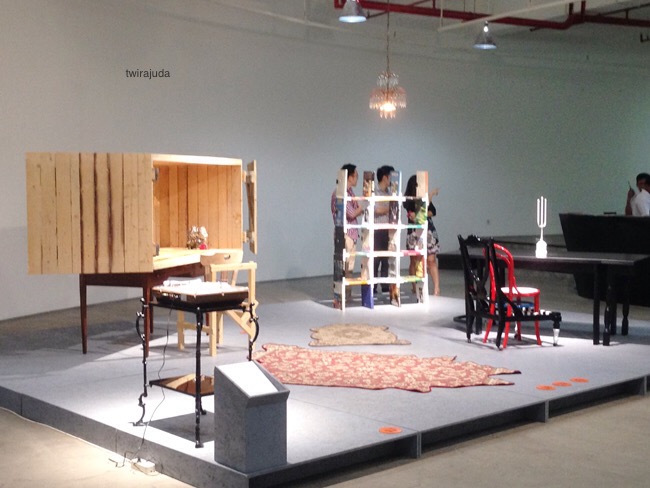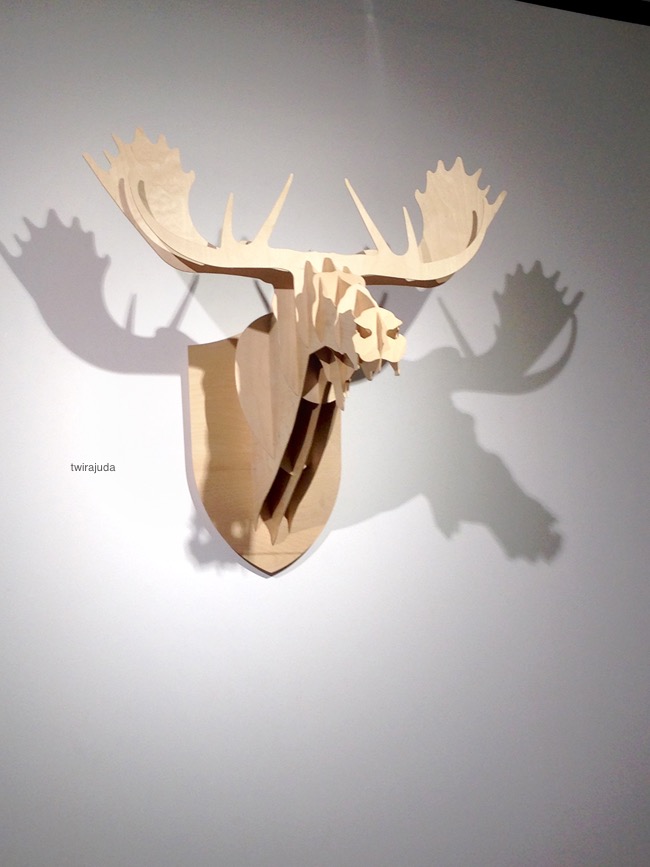
“Hello” by Bagus Pandega, and “Hit It” by Stolen Wood (Photo courtesy of Tunggul Wirajuda)
The set of old-fashioned chairs around the small round table, which seemed to be transplanted from a 19th century cottage, epitomized controlled chaos. Suspended in midair, the chairs seemed to defy gravity as well as time and space. Titled “Hit It,” the installation piece by the German artistic duo of Kai Linke and Leslie “Lee” Hildebrandt — or Stolen Wood — fits the bill for its emphasis on adding a new twist to old things.
“Hit It” is part of “New Olds: Design Between Tradition and Innovation,” an exhibition of 60 works at Jakarta’s Art One Gallery featuring the works of designers from Germany and other European countries, as well as Indonesia and the United States. Held by the Goethe-Institut and Institut fur Auslandsbeziehungen or IFA, the exhibit set out to turn notions of designs around its head. “[New Olds: Design Between Tradition and Innovation] set out to explore the relationship between tradition and innovation in contemporary design,” the exhibition’s catalogue announced. “The variety of the many approaches are bundled around the theme’s material, construction, configuration, production, and traditional use.”
The exhibition’s curator, professor Volker Albus, reiterated the statement.
“The exhibition sought to see which old elements can be used to make contemporary designs. The question is, what [old designs] can we take and how can we take it, and how can we transform them into new, contemporary and local items,” he said. “We also encourage local artists to look [for inspiration] at their culture instead of foreign, particularly Western models.”
One Indonesian artist, Bagus Pandega, got the message through his work “Hello.” At first glance, the Bandung Institute of Technology Fine Arts alumnus seemed to pay homage to the turntable. But as his choice of materials indicates, there is much more than meets the eye. “Hello” uses acrylic for the turntable instead of vinyl, as the former has a more futuristic look. The turntable itself is a running text playing the Beatles classic song “Hello Goodbye,” as in “hello to the new, goodbye to the old,” Bagus said.
Fellow Indonesian artist Patricia Untario also touched on the same issue with her work “Rangka”or “Frame.”
“I found this Art Nouveau lamp at the Astana Anyar flea market in Bandung. When I found it, the lamp was so rusty and dirty it didn’t take long to realize that there’s a history behind it,” she said. “When one thinks of chandeliers, they think ornate lamps, so people have no idea I got the lamp in a rundown condition once they see its restored state. I guess ‘Rangka’ is a good metaphor for the wonders that we tend to overlook in daily life, until we stop to take a closer look at it.”
On the other hand, Dila and Otong’s piece “The Javanese Queen” pays tribute to their cultural heritage.
“Javanese traditions are very robust. We are also rooted in Java and it is difficult to separate us from her,” they said of the bust, whose refined wayang features are counterpointed by the ornate, carnival like decoration. “If we had to describe Java as a queen, we would see her mysterious side and the elegance of traditions in the place where we grew up.”
Other collections in the exhibition, such as Studio Nils and Sven’s “1000 Chairs,” also approach the theme with a knack for the unexpected and a quirky eye. Designed by Niels Kerkkamp and Sven Lamme from five strips of plywood measuring five centimeters, the chair seemed more geared for decoration. But the chair was surprisingly ergonomic, as it featured good weight distribution and balance.
Others, such as Soner Ozenc’s “El Sajjadah” and Wendy Plomp’s “Message in a Box” series touched on the place of faith, in this sense Islam, in the modern world. The stark white, computerized design of a prayer mat seem to touch on religion’s relevance in the modern world, making it contemporary yet timeless. But Plomp’s “Message in a Box” is no less poignant. Made of cardboard with the decorations typical of a prayer rug, the work’s sparse, no-nonsense simplicity seems to take faith to its simplest, most elemental characters.
Albus’ own work “Pixelperser” also has the same take. The carpet drew attention to the similarities between the pixels of modern computers and the intricate weaving process of Persian carpets, proving that the newest innovations have much in common with age old, hand made items than was previously thought.

“Moose, Roeder, Deer” by Big Game
Other works, like Big Game’s “Moose, Roeder, Deer” updated the age-old tradition of hanging hunting trophy heads on the wall for their wooden substitutes. Made with more ecological concerns in mind as well as an aversion to taking life, the work gave the tradition a new lease on life by its distinct aesthetic. Nina Kappenstein did the same with porcelain on her “dTales” pieces. Superficially resembling 18th-century scenes of pastoral life portrayed by Meissen porcelain from Germany, Kappenstein subtly slipped in symbols of consumer products such as McDonald’s and Coca Cola as well as planes flying overhead, to show how the world has changed since.
Originally published in The Jakarta Globe on December 4, 2013